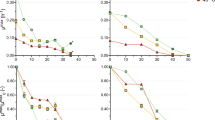Summary
The enzyme lactate dehydrogenase (LDH) in Clostridium thermohydrosulfuricum is controlled by the type and the concentration of the substrate. In batch fermentations an increase of the initial concentration of glucose leads to an increase in the activity of LDH. This increase in activity is related to the accumulation of fructose 1,6-diphosphate (F 1,6-DP), an intermediate of the Embden-Meyerhof-Parnas (EMP) pathway, which stimulates the enzyme by increasing its affinity for pyruvate and NADH. The K mvalues of LDH for pyruvate and NADH, which are 2.5×10-3 M and 9.1×10-5 M respectively in absence of F 1,6-DP, fall considerably in the presence of this substrate. In presence of 0.2 mM of F 1,6-DP we observed a K mof 3.3×10-4 M for pyruvate and 4.1×10-5 M for NADH.
Similar content being viewed by others
References
Ben-Bassat A, Lamed R, Zeikus JG (1981) Ethanol production by thermophilic bacteria: metabolic control of end product formation in Thermoanaerobium brockii. J Bacteriol 146:192–199
Brener D, Johnson BF (1984) Relationship between substrate concentration and fermentation product ratios in Clostridium thermocellum cultures. Appl Environ Microbiol 47:1126–1129
Brown AT, Wittenberger CL (1972) Fructose-1,6-diphosphate-dependent lactate dehydrogenase from cariogenic Streptococcus: purification and regulatory properties. J Bacteriol 110:604–615
Bücher T, Hohorst HJ (1965) Dihydroxyacetone phosphate, fructose-1,6-diphosphate and d-glyceraldehyde-3-phosphate: determination with glycerol-1-phosphate dehydrogenase, aldolase and triose-phosphate isomerase. In: Bergmeyer HU (ed) Methods of Enzymatic Analysis. Academic Press, New York, London, pp. 246–252
Crow VL, Pritchard GG (1977) Fructose-1,6-diphosphate-activated l-lactate dehydrogenase from Streptococcus lactis: kinetic properties and factors affecting activation. J Bacteriol 131:82–91
Giallo J, Gaudin C, Belaich JP, Petitdemange E, Caillet-Mangin F (1983) Metabolisme of glucose and cellobiose by cellulolytic mesophilic Clostridium sp. strain H10. Appl Environ Microbiol 45:843–849
Hyun HH, Zeikus JG (1985) Simultaneous and enhanced production of thermostable amylases and ethanol from starch by cocultures of Clostridium thermosulfurogenes and Clostridium thermohydrosulfuricum. Appl Environ Microbiol 49:1174–1181
Lamed R, Zeikus JG (1980a) Glucose fermentation pathway of Thermoanaerobium brockii. J Bacteriol 141:1251–1257
Lamed R, Zeikus JG (1980b) Ethanol production by thermophilic bacteria: relationship between fermentation product yields of and catabolic enzyme activities in Clostridium thermocellum and Thermoanaerobium brockii
Lowry OH, Rosebrough NJ, Farr AL, Randall RJ (1951) Protein measurement with the Folin phenol reagent. J Biol Chem 193:265–275
Mancuso A (1982) Xylose fermentation by Clostridium thermohydrosulfuricum. Thesis M.S., University of California, Berkeley
Ng TK, Ben-Bassat A, Zeikus JG (1981) Ethanol production by thermophilic bacteria: fermentation of cellulosic substrates by coculture of Clostridium thermocellum and Clostridium thermohydrosulfuricum. Appl Environ Microbiol 41:1337–1343
Saddler JN, Chan MK-H (1983) Conversion of pretreated lignocellulosic substrates to ethanol by Clostridium thermocellum in mono-and co-culture with Clostridium thermosaccharolyticum and Clostridium thermohydrosulfuricum. Can J Microbiol 30:212–220
Thomas TD, Ellwood DC, Longyer VMC (1979) Change from homo-to heterolactic fermentation by Streptococcus lactis resulting from glucose limitation in anaerobic chemostat cultures. J Bacteriol 138:109–117
Wiegel J (1980) Formation of ethanol by bacteria. A pledge for the use of extreme thermophilic anaerobic bacteria in industrial ethanol fermentation processes. Experientia 36:1434–1446
Wiegel J, Ljungdahl LG, Rawson JR (1979) Isolation from soil and properties of the extreme thermophile Clostridium thermohydrosulfuricum. J Bacteriol 139:800–810
Yamada T, Carlsson J (1975) Regulation of lactate dehydrogenase and change of fermentation products in Streptococci. J Bacteriol 124:55–61
Zeikus JG (1980) Chemical and fuel production by anaerobic bacteria. Ann Rev Microbiol 34:423–464
Zeikus JG, Ben-Bassat A, Hegge PW (1980) Microbiology of methanogenesis in thermal, volcanic environments. J Bacteriol 143:432–440
Zeikus JG, Ben-Bassat A, Ng TK, Lamed RJ (1981) Thermophilic ethanol fermentations. In: Trends in the biology of fermentation for fuels and chemicals. Hollaender A (ed) Plenum Publishing Corp. New York, pp. 441–461
Zeikus JG, Ng TK (1982) Thermophilic saccharide fermentations. In: Annual Reports on Fermentation Processes. Tsao GT (ed) Vol.5. Academic Press, New York, pp. 261–289
Author information
Authors and Affiliations
Rights and permissions
About this article
Cite this article
Germain, P., Toukourou, F. & Donaduzzi, L. Ethanol production by anaerobic thermophilic bacteria: regulation of lactate dehydrogenase activity in Clostridium thermohydrosulfuricum . Appl Microbiol Biotechnol 24, 300–305 (1986). https://doi.org/10.1007/BF00257053
Received:
Revised:
Issue Date:
DOI: https://doi.org/10.1007/BF00257053




